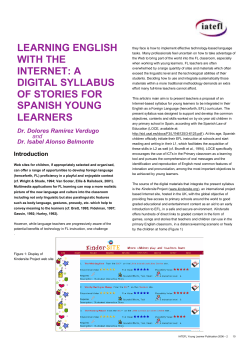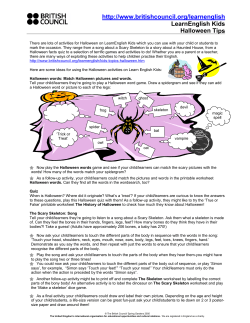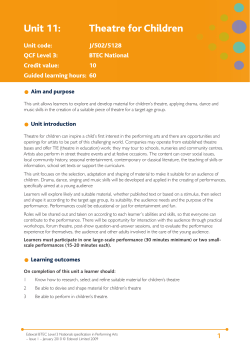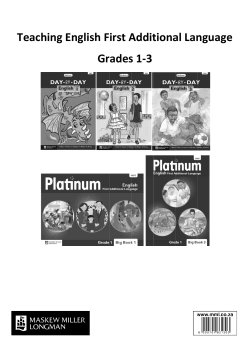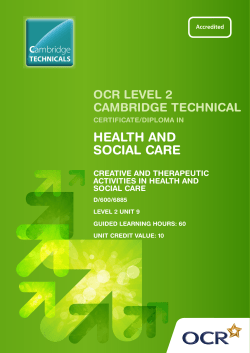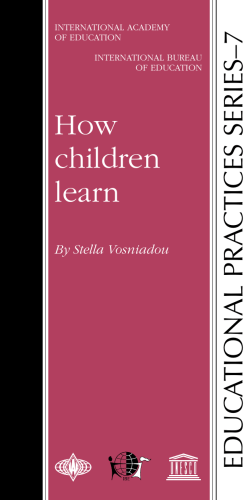
Unit 13: Advanced Skills and Techniques in Producing Desserts and Petits Fours
Unit 13: Advanced Skills and Techniques in Producing Desserts and Petits Fours Unit code: J/600/9165 QCF Level 3: BTEC National Credit value: 13 Guided learning hours: 115 Aim and purpose The aim of this unit is to enable the candidate to develop the necessary advanced skills knowledge and understanding of the principles in producing hot, cold and frozen desserts and petits fours and friandises. The emphasis in this unit is to develop precision, speed and control in existing skills and develop more refined and advanced techniques. Unit introduction Pastry chefs focus on preparing, baking and decorating cakes, breads, cookies and pastries. Also known as pâtissier chefs, they work in restaurants, hotels, commercial bakeries, grocery store bakery departments, catering businesses, banquet halls or any other institutional settings where dessert foods are enjoyed. Dessert and pastry chefs plan food budgets, research and experiment with new flavours and techniques and ensure the quality of ingredients and cooking utensils. They also need a solid background in mathematics and science. This is because their work involves lots of calculation for ingredient measuring, weighing, and adjusting; science education is also useful because the way ingredients combine to produce a desired result is itself a study in chemistry. In this unit learners will look at ingredients, equipment, storage, preparation, cooking and finishing methods used to produce dessert and petits fours. Learners will develop their practical dessert and petits fours preparation, cooking and finishing skills, and learn to work in a professional, safe and hygienic manner. They should be encouraged to use healthy eating techniques and this should be reflected in the production methods and ingredients used. Learners will also be introduced to the processes involved in evaluating their working methods. They are required to make recommendations for future improvements in the quality of their products and in the way in which they organise their practical work. Learning outcomes On completion of this unit a learner should: 1 Be able to produce hot, cold and frozen desserts 2 Be able to produce petits fours and friandises. Edexcel BTEC Level 3 Nationals specification in Hospitality – Issue 2 – November 2011 © Pearson Education Limited 2011 1 Unit content 1 Be able to produce hot, cold and frozen desserts Dessert and petit fours products: bread and dough products (enriched dough, laminated dough) eg brioche; cakes, sponges, biscuits and scones eg gateaux, tortes; pastry products (short, sweet, suet, choux, strudel, puff/flaky, sablé, convenience, hot water paste) eg apple strudel, custard tarts; chocolate products (plain, white, milk) eg truffles; marzipan, pastillage and sugar products (sugar paste, royal icing, spun sugar, dipped fruit, Italian meringue, fudge, poured sugar, rock sugar) eg wedding cakes; hot desserts (hot soufflés, paste based, fruit based desserts, sponge based desserts); cold and frozen desserts (egg based set, mousses, meringue based, cheesecake, paste based goods, fruit bavarois, ice cream based) eg sorbet; sauces, fillings and coatings for desserts (crème anglaise, sabayon, fruit coulis, ganache, crème chantilly, preserves, fruit glazes, crème patisserie, syrups, butter cream, jams, sugar glazes); matching relevant fillings and refined sauces for desserts Ingredients: types eg milk and milk products, eggs and egg products, fats, oils, fresh, dry goods, frozen, chilled, tinned; storage eg chilled; ingredients balance in recipe Professional: attitude; high standard of personal appearance including proper uniform; good hygienic practices; attentiveness; body language; attention to detail; treating colleagues with respect; effective communications eg listening, speaking, relaying messages and orders accurately and promptly; teamwork; codes of practice; safe and hygienic working practices to include cross-contamination; temperature monitoring; critical control points Equipment: large eg ovens, mixing machines, fryers, provers, refrigerators, deep freezers, salamanders, steamers; small eg baking sheets, brushes, cutters, dredgers, moulds, piping bags/tubes, sieves, sugar boilers, thermometers 2 Be able to produce petits fours and friandises Preparation: methods and techniques eg creaming, folding, aeration, use of moulds, incorporating fat, separation/combination of colours, flavours and ingredients, combining, sieving/passing, pureeing, addition of flavours/colours, straining, weighing/measuring, sifting, rubbing in, kneading, resting, conditioning/ chilling, laminating, rolling, lining/moulding, trimming, proving, knocking back, shaping, greasing, dipping, moulding, pouring, rolling, drying, pulling, manipulating, cutting, spreading, spinning, melting, tempering, modelling, mixing, whisking, reducing, liquidising, blending, emulsifying Cooking: methods and techniques eg steaming, deep frying, shallow frying, bain-marie, baking, re-heating, microwaving, poaching, boiling, combination cooking methods; effects of preparation and cooking methods on the end product; timing; quality; selecting and using appropriate ingredients and equipment; safe storage of cooked/processed dessert and pastry products not for immediate use Finishing: methods eg gratinating, cooling, piping, de-moulding, glazing, portioning, freezing, refrigeration, chilling, stacking, filling, cutting, rolling, trimming/smoothing, dusting/dredging/sprinkling, coating; techniques; time planning; quality; selecting and using appropriate ingredients and equipment; presentation of the desserts/petits fours to meet requirements Evaluation techniques: qualitative; quantitative; sources of information eg self, peer and customers; product analysis and assessment sheets; feedback; recommendations for development and improvement Quality monitoring criteria: working methods; timing; appearance; taste; colour; texture; presentation; cost 2 Edexcel BTEC Level 3 Nationals specification in Hospitality – Issue 2 – November 2011 © Pearson Education Limited 2011 Assessment and grading criteria In order to pass this unit, the evidence that the learner presents for assessment needs to demonstrate that they can meet all the learning outcomes for the unit. The assessment criteria for a pass grade describe the level of achievement required to pass this unit. Assessment and grading criteria To achieve a pass grade the evidence must show that the learner is able to: To achieve a merit grade the evidence must show that, in addition to the pass criteria, the learner is able to: P1 demonstrate professional practices [SM 1, 2, 3] M1 explain the type and quantity of ingredients needed for selected desserts P2 produce hot, cold and frozen desserts to recipe specifications using advanced skills and techniques [SM 1, 2, 3] M2 explain reasons for specific equipment being used when carrying out selected preparation and cooking methods P3 finish hot, cold and frozen desserts using advanced skills and techniques P4 present dishes to meet styles of service [CT 1] P5 evaluate finished dishes [RL 1, 4, 5] P6 implement correct storage procedures P7 describe advanced preparation techniques for the production of desserts P8 explain considerations when balancing ingredients in recipes P9 explain the effect of preparation and/or cooking methods on the end product To achieve a distinction grade the evidence must show that, in addition to the pass and merit criteria, the learner is able to: P10 identify relevant fillings and refined sauces for desserts P11 describe the quality points for a range of desserts P12 describe how to control time, temperature and environment to achieve desired outcome when producing desserts Edexcel BTEC Level 3 Nationals specification in Hospitality – Issue 2 – November 2011 © Pearson Education Limited 2011 3 Assessment and grading criteria To achieve a distinction grade the evidence must show that, in addition to the pass and merit criteria, the learner is able to: To achieve a pass grade the evidence must show that the learner is able to: To achieve a merit grade the evidence must show that, in addition to the pass criteria, the learner is able to: P13 demonstrate professional practices M3 demonstrate creativity in the D1 preparation, cooking and finishing of desserts and petits fours P14 produce petits fours and friandises to recipe specifications using advanced M4 use quality criteria to review desserts and petits fours. skills and techniques assess own performance using quality monitoring criteria and make realistic recommendations for areas in which skills could be developed. P15 finish petits fours and friandises using advanced skills and techniques P16 present dishes to meet styles of service P17 evaluate finished dishes P18 implement correct storage procedures P19 describe advanced preparation techniques for the production of petits fours and friandises P20 state how to adjust the quantity of ingredients to give the correct portion yield from petits fours [IE 2] P21 explain the effect of cooking methods on the end product P22 describe the quality points for a range of petits fours and friandises P23 describe how to control time, temperature and environment to achieve desired outcome when producing petits fours. PLTS: This summary references where applicable, in the square brackets, the elements of the personal, learning and thinking skills applicable in the pass criteria. It identifies opportunities for learners to demonstrate effective application of the referenced elements of the skills. Key 4 IE – independent enquirers RL – reflective learners SM – self-managers CT – creative thinkers TW – team workers EP – effective participators Edexcel BTEC Level 3 Nationals specification in Hospitality – Issue 2 – November 2011 © Pearson Education Limited 2011 Essential guidance for tutors Delivery Professionalism in the hospitality industry is vital both to the success of the hospitality business and to learners’ future careers. Employers will expect recruits to demonstrate a professional attitude to their work, to themselves, and to their colleagues, customers and employers. Tutors must reinforce the importance of maintaining a professional attitude, in terms of personal, social and technical skills and safe and hygienic working practices. This unit has a practical component and focuses on the development of dessert and petits fours preparation, cooking and finishing skills. Learners must have the opportunity to explore different types of dessert and petits fours products, as well as to develop a wide range of knowledge and practical skills. Products must be produced to a standard and quality suitable for paying customers, although learners will need extensive support during the initial stages of delivery. The evaluation of dessert and petits fours products, when they have been prepared and cooked, is an important part of the unit and learners will initially need guidance on how best to do it. Later, however, learners should take greater control over the evaluation of dessert and petits fours products, while still involving the tutor as an informed observer. Learners need to recognise specific types of dessert and petits fours products and the ingredients used in their production. They also need to understand how specific ingredients are handled, stored and combined to produce the required dessert and petits fours product. The characteristics of dessert and petits fours products could be researched through the internet, recipe books and discussions, with learners then identifying key examples. Learners need to understand, and appreciate the importance of, specific preparation, cooking and finishing techniques and methods used in the production of dessert and petits fours products. Learners must be taught to recognise both large and small specialist equipment and understand their use. They should also be given the opportunity to use this equipment in a practical situation and, if possible, they should visit a large-scale commercial operation to observe equipment being used. Most of this unit will need to be delivered within a practical environment and involves developing and evidencing good practical skills alongside professional, safe and hygienic work practices. Learners should build up evidence of this learning through the collection of recipes, digital photographs and product analysis and assessment sheets. It will be necessary for learners to undertake detailed reviews and evaluations of the products that have been produced and for this feedback to be used in a constructive manner to achieve an improvement in performance. This evaluation must include self, peer and both internal and external customer groups and feedback must be analysed and presented in an appropriate format. The application of evaluation techniques and criteria will also make a valuable contribution to the learner’s future role as a supervisor in the hospitality industry. Edexcel BTEC Level 3 Nationals specification in Hospitality – Issue 2 – November 2011 © Pearson Education Limited 2011 5 Outline learning plan The outline learning plan has been included in this unit as guidance and can be used in conjunction with the programme of suggested assignments. The outline learning plan demonstrates one way in planning the delivery and assessment of this unit. Topic and suggested assignments/activities and/assessment Introduction to the unit, subject and the role of the dessert and pastry chef. Group discussion to determine learners’ knowledge of dessert and petits fours products. Visit to reputable industrial dessert and petits fours production business, such as a patisserie or bakery to find out about the types of dessert and petits fours products available and the types of ingredients used for their production and their correct handling and storage. Video or practical demonstration of the preparation, cooking and finishing techniques and methods used in dessert and petits fours production. Introduction to practical work with a presentation on how to maintain professional, safe and hygienic work practices in the practical area. Group discussion about considerations when balancing ingredients in recipes. Group discussion about the effect of preparation and cooking methods on the end product. Learners plan their practical sessions to include food requisitions and time plans. Exercise – learners follow demonstration and work professionally, safely and hygienically to prepare, cook and finish a range of hot, cold and frozen dessert products. Present finished products. Cooking practice and evaluation of finished dishes with feedback from tutor and peers – and repeat practice. Exercise – learners identify relevant fillings and refined sauces for different desserts. Exercise – learners implement correct storage procedures. Group discussion about the quality points for a range of desserts. Group discussion on how to control time, temperature and environment to achieve desired outcome when producing desserts. Assignment 1 – Producing Hot, Cold and Frozen Desserts (P1, P2, P3, P4, P5, P6, P7, P8, P9, P10, P11, P12, M1, M2) Learners produce a recipe booklet for the products they have created. This booklet should incorporate product analysis and assessment sheets for each product, which should be used to gather self, peer and customer feedback. Introduction to practical work with a presentation on how to maintain professional, safe and hygienic work practices in the practical area and the advanced preparation techniques for the production of petits fours and friandises. Group discussion about how to adjust the quantity of ingredients to give the correct portion yield from petits fours. Group discussion about the effect of cooking methods on petits fours. Learners plan their practical sessions to include food requisitions and time plans. Exercise – learners follow demonstration and work professionally, safely and hygienically to prepare, cook and finish a range of petits fours and friandises products. Present finished products. Cooking practice and evaluation of finished dishes with feedback from tutor and peers – and repeat practice. Exercise – learners implement correct storage procedures. Group discussion about the quality points for a range of petits fours and friandises. Group discussion on how to control time, temperature and environment to achieve desired outcome when producing petits fours and friandises. 6 Edexcel BTEC Level 3 Nationals specification in Hospitality – Issue 2 – November 2011 © Pearson Education Limited 2011 Topic and suggested assignments/activities and/assessment Assignment 2 – Producing Petits Fours and Friandises (P13, P14, P15, P16, P17, P18, P19, P20, P21, P22, P23, M3, M4, D1) Learners produce a recipe booklet for the products they have created. This booklet should incorporate product analysis and assessment sheets for each product, which should be used to gather self, peer and customer feedback. Tutorial support and feedback. Self-initiated learning time. Assessment Any evidence submitted for criteria requiring the practical demonstration of skills, eg the ability to work independently, must be supported by observation sheet(s) signed by the assessor and identify how specific criteria have been met. The sub-headings in this section mirror the funnelling opportunities in the grading grid. They suggest how assessment can be grouped to allow learners to progress to the higher grades; however, they are not prescriptive. P1 – P2 – P3 – P4 – P5 – P6 – P7 – P8 – P9 – P10 – P11 – P12 – M1 – M2 P1 requires learners to demonstrate professional, safe and hygienic practices while producing hot, cold and frozen desserts. For P2, learners must produce hot, cold and frozen desserts to recipe specifications using advanced skills and techniques with appropriate tutor and team support. The tutor should give learners a free hand to produce the selected products, but it is likely that the tutor will need to be available as a source of advice and guidance. Team support could come from other members of the same or related courses. The items produced must be of a standard and quality suitable for paying customers. This criterion should be evidenced by self, peer, tutor and customer feedback from product analysis and assessment sheets produced by the learner. For P3, learners must finish hot, cold and frozen desserts using advanced skills and techniques with appropriate tutor and team support. The tutor should give learners a free hand to finish the selected products, which could be the same ones produced for P2, but it is likely that the tutor will need to be available as a source of advice and guidance. Team support could come from other members of the same or related courses. The products must be finished to specifications in terms of quality, quantity, appearance and temperature, within an appropriate timescale, and at the correct time and place. This criterion should be evidenced by self, peer, tutor and customer feedback from product analysis and assessment sheets produced by the learner. P4 requires learners to present the desserts they have produced and finished to meet the styles and requirements of service appropriate to two different hospitality businesses. For P5, learners need to evaluate finished dessert products. Using the quality monitoring criteria highlighted in the product analysis and assessment sheets, learners should evaluate which criteria could be applied to specific products that they or other learners have produced. Not all criteria will be equally relevant; learners could apply different criteria to different dishes, but should use each at least once. P6 requires learners to implement correct storage procedures for three different finished dessert products not for immediate use. Edexcel BTEC Level 3 Nationals specification in Hospitality – Issue 2 – November 2011 © Pearson Education Limited 2011 7 For P7, learners must describe advanced techniques, methods and equipment used for the production and finishing of different dessert products. Evidence could be in the form of a presentation or report describing what and why specific production and finishing techniques and methods are used in the production of the products selected for P2. For P8, learners must explain the type, quality and quantity of ingredients needed for dessert products. Evidence could be in the form of a presentation or report. Learners could research and plan to produce a range of products for a dessert buffet at a function such as a wedding reception. The selected products should be to an accepted budget (set realistically after research) and also be balanced and nutritionally sound. For P9, learners must explain the effect of preparation and/or cooking methods on the end product. The evidence could take a written format, possibly after a group discussion. To achieve P10, learners must identify relevant fillings and refined sauces for one hot, one cold and one frozen dessert. P11 requires learners to describe the quality points for one hot, one cold and one frozen dessert. For P12, learners must describe how to control time, temperature and environment to achieve the desired outcome when producing one hot, one cold and one frozen dessert. M1 builds on P2 and P3. Learners have to explain the type and quantity of ingredients needed for selected dessert products. Learners should identify commodities appropriate to the selected products. They should research where the identified commodities could be sourced in the quantities required using the appropriate sizes and quantities for their requirements. M2 requires learners to explain reasons for specific equipment being used when carrying out selected preparation and cooking methods. Learners could build on the work done for P2. P13 – P14 – P15 – P16 – P17 – P18 – P19 – P20 – P21 – P22 – P23 – M3 – M4 – D1 P13 requires learners to demonstrate professional, safe and hygienic practices while producing petits fours. For P14, learners must produce petits fours and friandises to recipe specifications using advanced skills and techniques with appropriate tutor and team support. The tutor should give learners a free hand to produce the selected products, but it is likely that the tutor will need to be available as a source of advice and guidance. Team support could come from other members of the same or related courses. The items produced must be of a standard and quality suitable for paying customers. This criterion should be evidenced by self, peer, tutor and customer feedback from product analysis and assessment sheets produced by the learner. For P15, learners must finish petits fours and friandises using advanced skills and techniques with appropriate tutor and team support. The tutor should give learners a free hand to finish the selected products, which could be the same ones produced for P14, but it is likely that the tutor will need to be available as a source of advice and guidance. Team support could come from other members of the same or related courses. The products must be finished to specifications in terms of quality, quantity, appearance and temperature, within an appropriate timescale, and at the correct time and place. This criterion should be evidenced by self, peer, tutor and customer feedback from product analysis and assessment sheets produced by the learner. P16 requires learners to present the petits fours and friandises they have produced and finished to meet the styles and requirements of service appropriate to two different hospitality businesses. For P17, learners need to evaluate petits fours and friandises products. Using the quality monitoring criteria highlighted in the product analysis and assessment sheets, learners should evaluate which criteria could be applied to specific products that they or other learners have produced. Not all criteria will be equally relevant; learners could apply different criteria to different dishes, but should use each at least once. 8 Edexcel BTEC Level 3 Nationals specification in Hospitality – Issue 2 – November 2011 © Pearson Education Limited 2011 P18 requires learners to implement correct storage procedures for three different finished petits fours and friandises products not for immediate use. For P19, learners must describe advanced techniques, methods and equipment used for the production of petits fours and friandises products. Evidence could be in the form of a presentation or report describing what and why specific production and finishing techniques and methods are used in the production of the products selected for P14. For P20, learners must state how to adjust the quantity of ingredients to give the correct portion yield from petits fours. Evidence could be in the form of a presentation or report. Learners could research and plan to produce a range of products for a dessert buffet at a function such as a wedding reception. The selected products should be to an accepted budget (set realistically after research) and also be balanced and nutritionally sound. For P21, learners must explain the effect of cooking methods on the end product. The evidence could take a written format, possibly after a group discussion. P22 requires learners to describe the quality points for three different types of petits fours and friandises. For P23, learners must describe how to control time, temperature and environment to achieve the desired outcome when producing three different types of petits fours. M3, builds on the skills shown in P13, P14 and P15. For M3, it is not enough for learners to follow a wellknown recipe; they should demonstrate creativity. For example, learners could take a traditional dessert and petit four and give it a modern style of presentation or interpretation such as eggplant and chocolate Napoleon. A further example could be a cupcake flavoured and topped with candied/crystallized sweet potato. The evidence will be practical and will need to include an observation sheet supported by other forms of evidence, such as digital photographs or tasting notes. M4 requires learners to apply quality criteria identified for P22 to at least six desserts and petits fours. These criteria could be applied to desserts and petits fours produced by themselves, by other learners, or by professional businesses, eg restaurants, patisseries. For D1, learners need to assess their own performance using quality monitoring criteria and make realistic recommendations for developing skills when preparing, cooking and finishing dessert and petits fours. This should be based on analysis of the products produced and feedback from peers and customers, but should also, where necessary, incorporate other relevant areas, such as specific preparation or cooking skills. Areas of strength and weakness should be identified, and realistic suggestions for improvement made. Edexcel BTEC Level 3 Nationals specification in Hospitality – Issue 2 – November 2011 © Pearson Education Limited 2011 9 Programme of suggested assignments The table below shows a programme of suggested assignments that cover the pass, merit and distinction criteria in the assessment and grading grid. This is for guidance and it is recommended that centres either write their own assignments or adapt any Edexcel assignments to meet local needs and resources. Criteria covered Assignment title Scenario Assessment method P1, P2, P3, P4, P5, P6, P7, P8, P9, P10, P11, P12, M1, M2 Producing Hot, Cold and Frozen Desserts Learners take the role of a pastry chef and have been asked to produce hot, cold and frozen desserts. Learners produce a leaflet of the recipes used including pictures of the dishes produced. Learners provide video evidence or photographs of dishes produced. P13, P14, P15, P16, P17, P18, P19, P20, P21, P22, P23, M3, M4, D1 Producing Petits Fours and Friandises Learners continue with their role as pastry chefs and have been asked to produce petits fours and friandises. Learners produce a leaflet of the recipes used including pictures of the dishes produced. Learners provide video evidence or photographs of dishes produced. Links to National Occupational Standards, other BTEC units, other BTEC qualifications and other relevant units and qualifications This unit forms part of the BTEC Hospitality suite. This unit has particular links with the following unit titles in the Hospitality suite: Level 2 Level 3 Prepare, Cook and Finish Food European Food Contemporary World Food Asian Food Contemporary World Food Essential resources Learners will need access to a realistic work environment or a real work situation. Employer engagement and vocational contexts Where possible, employers should be involved with this unit by supplying opportunities for learners to visit their businesses, speakers with appropriate expertise to talk to learners and work placements. The practical part of this unit should take place in a commercial context. If this is not possible within the centre, a link with a local employer or collaboration with a college with appropriate realistic work environments could facilitate this. 10 Edexcel BTEC Level 3 Nationals specification in Hospitality – Issue 2 – November 2011 © Pearson Education Limited 2011 Indicative reading for learners Textbooks Friberg B – The Professional Pastry Chef, 4th Edition (John Wiley & Sons, 2002) ISBN 9780471359258 Friberg B – The Advanced Professional Pastry Chef, 5th Edition (John Wiley & Sons, 2003) ISBN 9780471432838 Hamlyn – Larousse Gastronomique: Desserts, Cakes and Pastries (Hamlyn, 2006) ISBN 9780600615774 Hanneman L – Patisserie, 2nd Edition (Butterworth-Heinemann, 2005) ISBN 9780750669283 Parkinson E – The Complete Confectioner, Pastry-cook, and Baker (BiblioLife, 2009) ISBN 9781110347353 Journals Caterer and Hotelkeeper – Reed Business Information Delicious magazine – Seven Publishing Olive – BBC worldwide Restaurant – Reed Publishing Stockpot – (Craft Guild of Chefs), Pensord Yes chef! magazine – Network Group Websites www.bbc.co.uk/food BBC Food pages www.bbc.co.uk/learningzone BBC Learning Zone – Programme times www.bha.org.uk British Hospitality Association www.caterersearch.com Caterersearch – Hospitality news www.catersource.com Catersource – Education, products and news for caterers www.compass.com Compass – Gateway to sites for business, travel, shopping www.people1st.co.uk People 1st – Sector Skills Council for Hospitality, Leisure, Travel and Tourism www.sodexo.com Sodexo – On-site service solutions and motivation solutions Edexcel BTEC Level 3 Nationals specification in Hospitality – Issue 2 – November 2011 © Pearson Education Limited 2011 11 Delivery of personal, learning and thinking skills The table below identifies the opportunities for personal, learning and thinking skills (PLTS) that have been included within the pass assessment criteria of this unit. Skill When learners are … Independent enquirers P20 stating how to adjust the quantity of ingredients to give the correct portion yield from petits fours [IE 2] Creative thinkers P4 presenting dishes to meet styles of service [CT 1] Reflective learners P5 evaluating finished dishes [RL 1, 4, 5] Self-managers P1 demonstrating professional practices [SM 1, 2, 3] P2 producing hot, cold and frozen desserts to recipe specifications using advanced skills and techniques [SM 1, 2, 3]. Although PLTS are identified within this unit as an inherent part of the assessment criteria, there are further opportunities to develop a range of PLTS through various approaches to teaching and learning. Skill When learners are … Effective participators identifying improvements to their working practices [EP 4]. 12 Edexcel BTEC Level 3 Nationals specification in Hospitality – Issue 2 – November 2011 © Pearson Education Limited 2011 Functional Skills – Level 2 Skill When learners are … ICT – Use ICT systems Select, interact with and use ICT systems independently for a complex task to meet a variety of needs Use ICT to effectively plan work and evaluate the effectiveness of the ICT system they have used Manage information storage to enable efficient retrieval Follow and understand the need for safety and security practices Troubleshoot ICT – Find and select information Select and use a variety of sources of researching websites about desserts and petits fours information independently for a complex task Access, search for, select and use ICTbased information and evaluate its fitness for purpose researching and selecting information on approaches to dessert and petits fours preparation and cooking ICT – Develop, present and communicate information Enter, develop and format information independently to suit its meaning and purpose including: ● text and tables ● images ● numbers ● records Bring together information to suit content and purpose Present information in ways that are fit for purpose and audience Evaluate the selection and use of ICT tools and facilities used to present information Select and use ICT to communicate and exchange information safely, responsibly and effectively including storage of messages and contact lists Edexcel BTEC Level 3 Nationals specification in Hospitality – Issue 2 – November 2011 © Pearson Education Limited 2011 13 Skill When learners are … Mathematics Understand routine and non-routine problems in a wide range of familiar and unfamiliar contexts and situations Identify the situation or problem and the mathematical methods needed to tackle it Select and apply a range of skills to find solutions Use appropriate checking procedures and evaluate their effectiveness at each stage Interpret and communicate solutions to practical problems in familiar and unfamiliar routine contexts and situations Draw conclusions and provide mathematical justifications English Speaking and listening – make a range of contributions to discussions and make effective presentations in a wide range of contexts discussing different types of dessert and petits fours products and the ingredients used in their production Reading – compare, select, read and understand texts and use them to gather information, ideas, arguments and opinions researching from textbooks, articles and websites to gather information on dessert and petits fours preparation and cooking Writing – write documents, including extended writing pieces, communicating information, ideas and opinions, effectively and persuasively preparing presentations, class notes, reports and written pieces of work on dessert and petits fours preparation and cooking. 14 describing the range of equipment, preparation, cooking and finishing methods used in the production of dessert and petits fours products Edexcel BTEC Level 3 Nationals specification in Hospitality – Issue 2 – November 2011 © Pearson Education Limited 2011
© Copyright 2025


